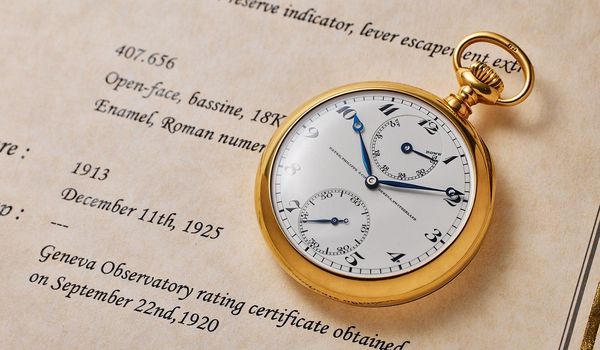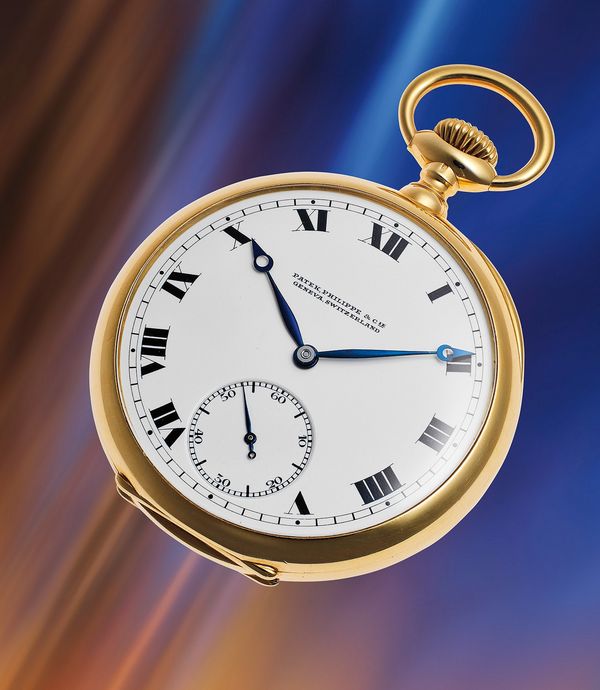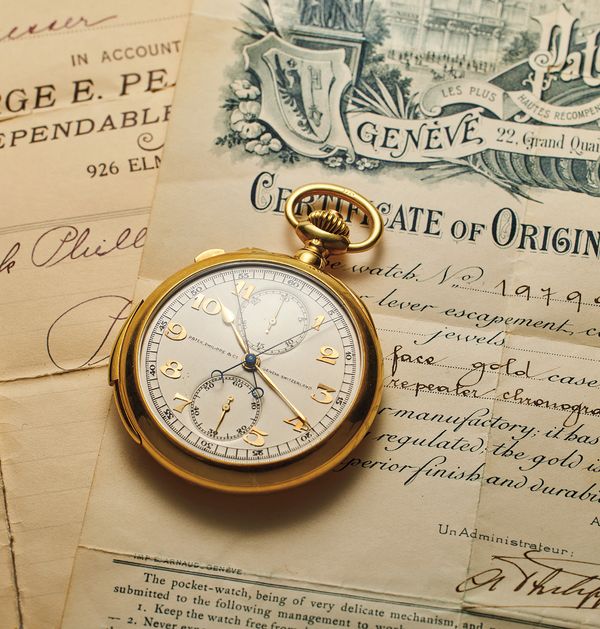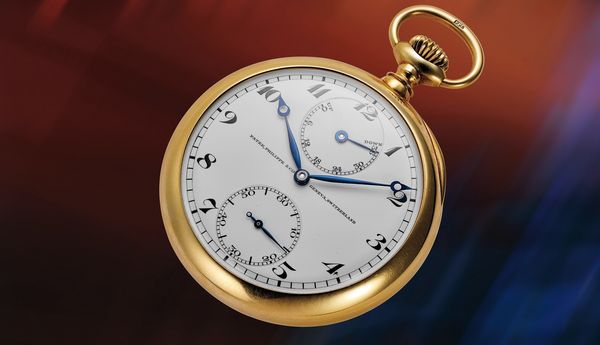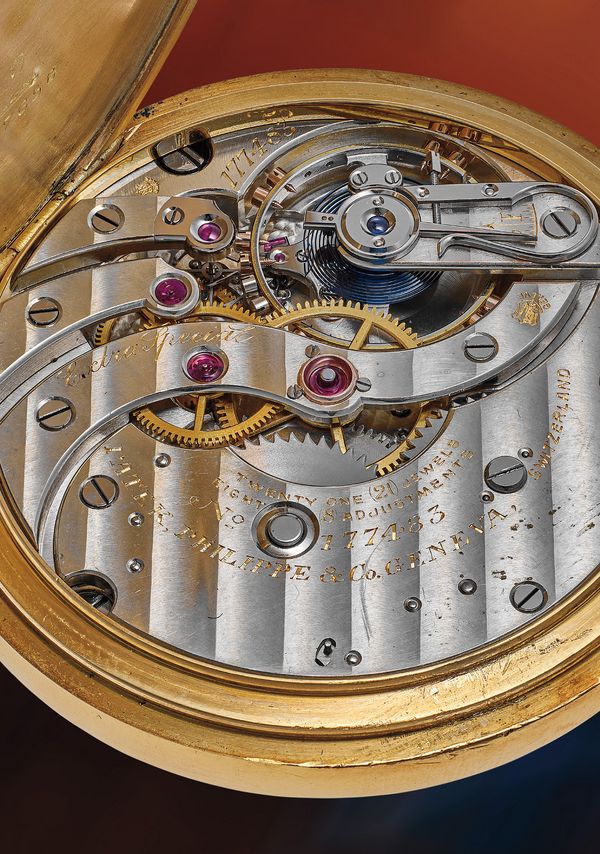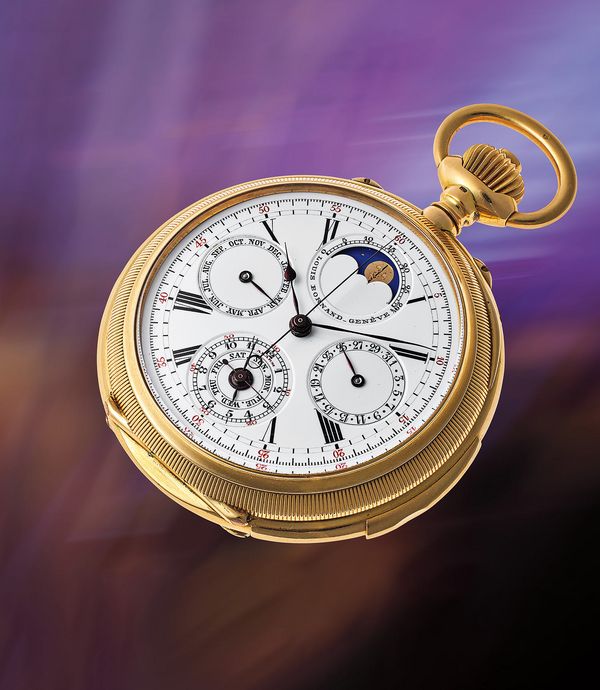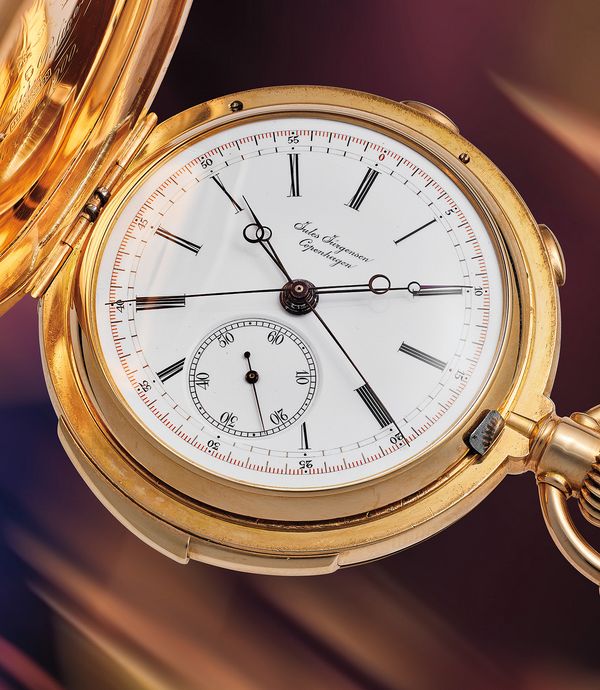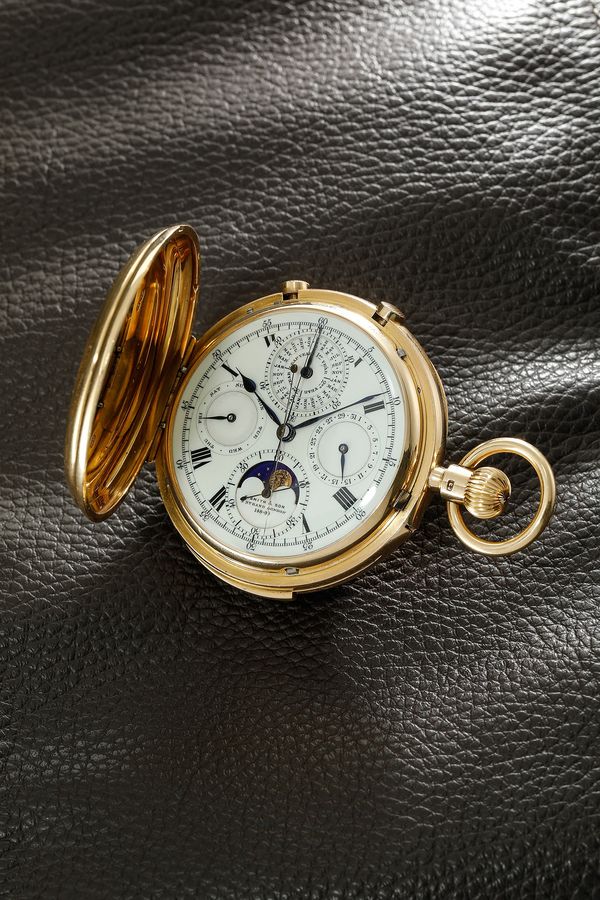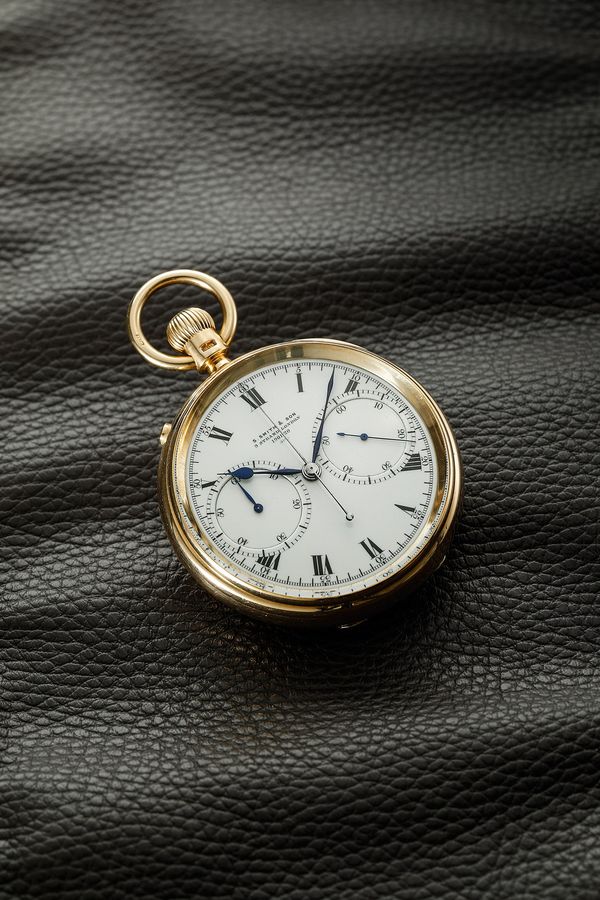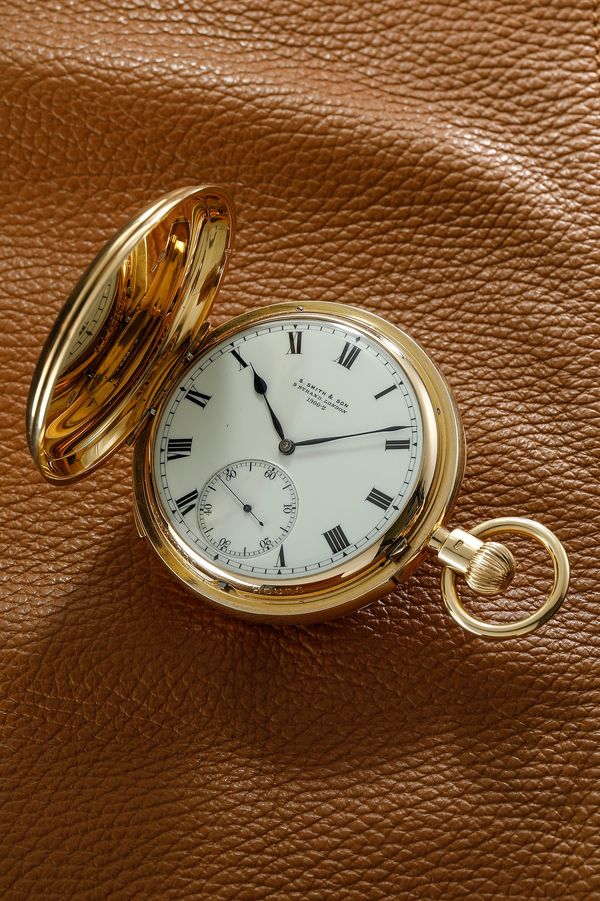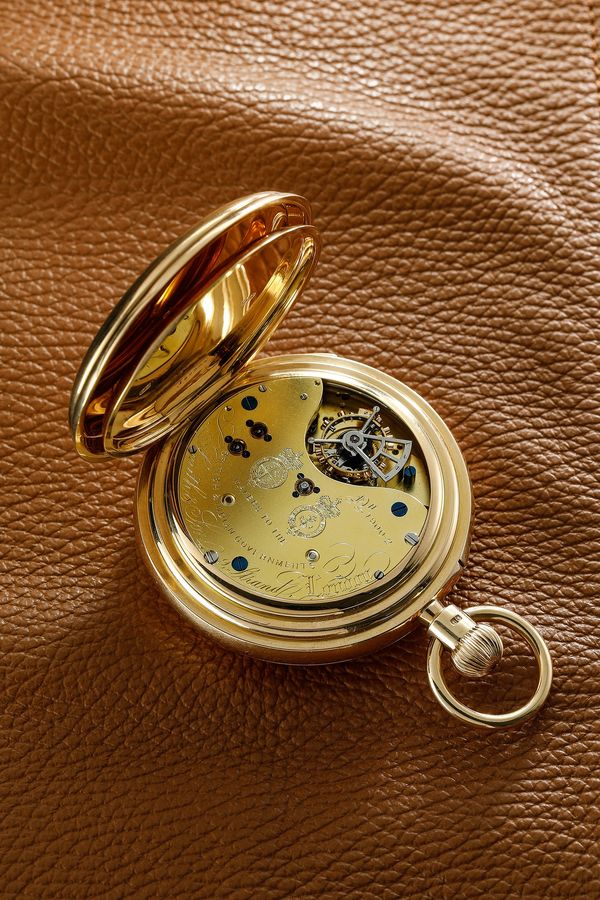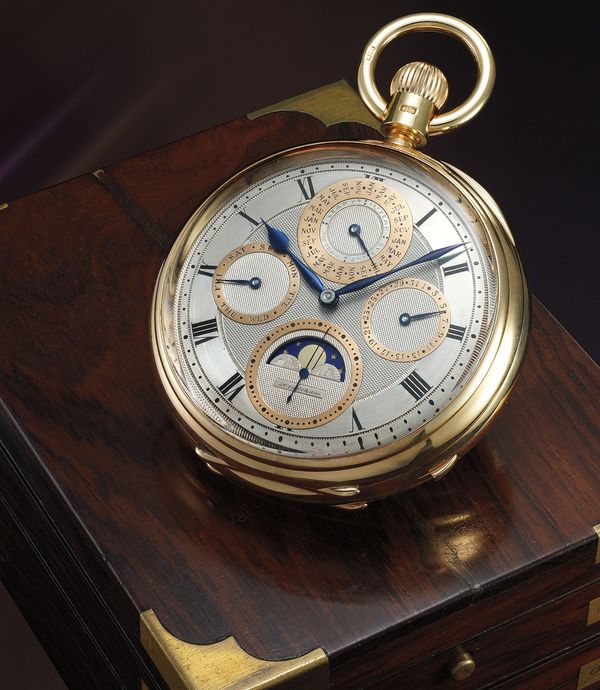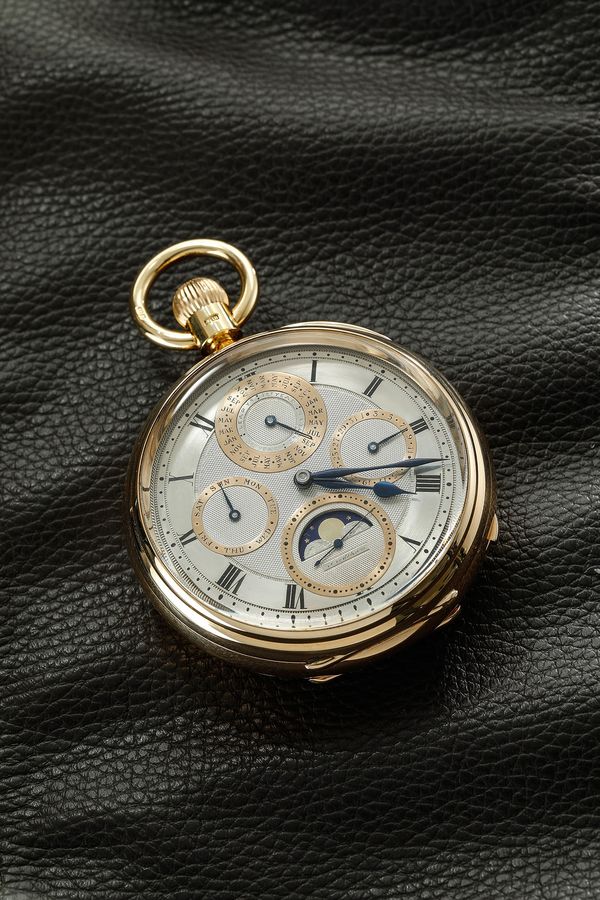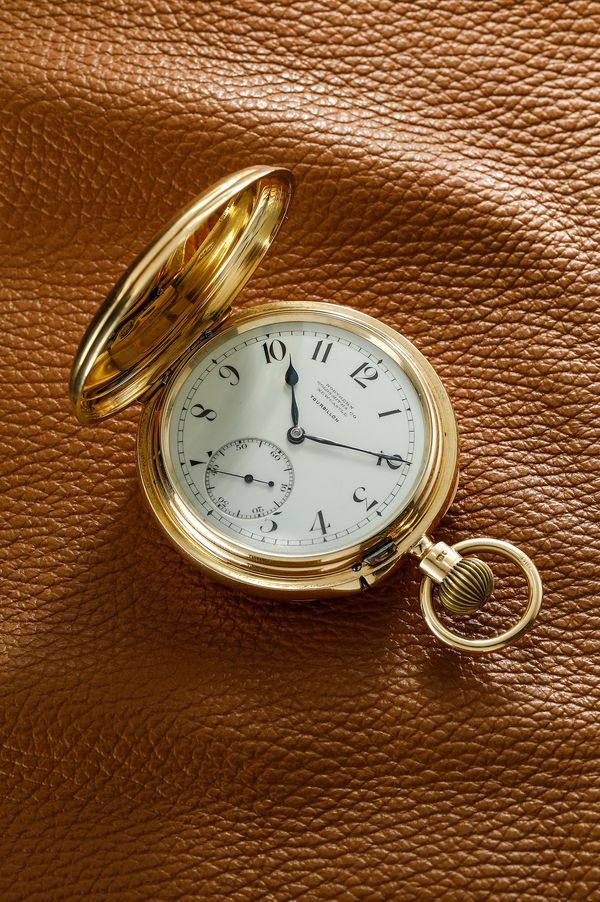The PHILLIPS New York Watch Auction: X, takes place on June 8 and 9, 2024, at our Park Avenue headquarters. The auction includes more than 150 of the world's finest watches – and though we are loath to boast, we truly think it's one of the best catalogs we've ever put together. We'll be highlighting a number of the most interesting lots and stories featured in the sale right here, including the wide variety of pocket watches featured below.
Lot 26: A 1912 Patek Philippe Pocket Watch in 18k Yellow Gold with Guillaume balance
Estimate: USD $4,000 - 8,000
The present openface pocket watch is a shining example of early 20th-century horology and the innovative technical skills demonstrated by the famous brand Patek Philippe. At first glance one may see a time only watch, however the movement is marked “Extra” a designation applied only to watches that have undergone even more rigorous testing, refinement, or enhancement beyond the brand's already high standards. Upon close inspection of the escapement, one notes the use of a Guillaume balance wheel with blued steel hairspring – the state-of-the- art at the time, used for the finest watches where precision timekeeping was of utmost importance.
Charles-Édouard Guillaume won the Nobel Prize in Physics in 1920, making significant contributions horology with his work on various nickel-steel alloys such as Invar and Elinvar. Guillaume balances with bimetallic rims made of Invar and brass, when used with blued steel hairsprings, are remarkably stable across a range of temperatures.
The present watch from circa 1915 is a wonderful example of the commitment to precision and accuracy in fine Swiss watchmaking. engraving on the movement indicates the watch was retailed by Wm. Senter & Co., a watchmaking firm located in Portland, Maine. William Senter (1850-c. 1926) apprenticed first to his uncle in 1870, also William Senter (1813-1888 ), and after his uncle's death in 1888, carried on their family business. As engraved on the cuvette, the “Extra”-grade movement was awarded “Awarded Honorable Mention Geneva Astronomical Observatory Timing Contest 1915-1916”. With a flawless enamel dial, it is offered in wonderful overall condition.
Lot 27: A 1925 Patek Philippe Minute Repeating Chronograph Pocket Watch in 18k Yellow Gold
Estimate: USD $20,000 - 40,000
The present open face pocket watch is a lovely example of a transitional period in horology when the fashionable pocket watch began giving way to the wristwatch. Cultural changes following World War I lead to the prominence of the wristwatch as a growing number of people began wearing them. The split-seconds mechanism, which allowed for the simultaneous timing of two events like horse and automobile racing, is relatively rare with fewer than 200 known pocket watch examples by Patek Philippe.
This example goes a significant step further, featuring a superb minute repeater mechanism. Chiming the exact time by repeating the hours, quarters, and minutes on two gongs, it has a loud, harmonious, and rich tone. Employing an uncommon vertically oriented, two register layout, the stunning dial features beautiful, applied gold Breguet numerals. The desirability of the timepiece is further enhanced by the inclusion of its original Certificate of Origin and bill of sale from 1933.
These early 20th century horological gems showcase the exceptional skill and craftsmanship, as well as the consistent historical excellence, that makes Patek Philippe watches so sought after in the modern era.
Lot 28: A 1913 Patek Philippe Chronometer Pocket Watch with 'Up-Down' Display, Made for Henry Graves Jr.
Estimate: USD $100,000 - 200,000
Phillips is honored to offer this wonderful, open-face pocket chronometer owned by Henry Graves Jr. Widely considered one of the 20th century's most important watch collectors, he is best remembered in the 21st century for his competition legendary with automobile entrepreneur James Ward Packard, to commission some of the most complicated timepieces ever produced. Graves would end up the ultimate victor, having commissioned the “Mona Lisa” of timepieces as described by Stacy Perman, author of “A Grand Complication”, the Patek Philippe Henry Graves Supercomplication. Delivered in 1933, with 24 complications and requiring over 8 years of development, it was the most complicated timepiece ever made, holding that distinction for over half a century.
Graves was born in 1868 to a prominent New York City family known for their banking and financial interests spanning railroads and cement – and dynastic wealth. Following in his father's footsteps, he became an accomplished collector establishing himself as one of the most discerning and influential connoisseurs across genres. Today, Graves is recognized for his keen eye for quality and for sparing no expense to acquire some of the most exquisite timepieces ever made by brands such as Patek Philippe, Jules Jurgensen, and Vacheron Constantin.
Before Graves' pursuit of ultimate complications, he sought the highest performing, most accurate timepieces produced by the finest watchmaking brands. Always Choosing 18 karat gold or platinum, he specifically requested from brands such as Patek Philippe, the #1 rated movements from annual chronometry competitions held at the Swiss Observatories – each hand-built and hand-adjusted by the brands' best watchmakers. Equivalent to Formula 1 race cars, these “observatory chronometers” were a nod to Graves' own pursuit of perfection and excellence. Before delivery to Graves, their cases would be engraved with his family motto, “Esse Quam Videri” – "To be, rather than to seem."
The present lot is certainly one such example. Fitted with an extremely fine movement equipped with a Guillaume balance and designated “Extra Special” on its bridge, the accompanying “Extract from the Archives” confirms the watch was issued a Geneva Observatory rating in September 1920.
According to research, the present lot was delivered to Bailey, Banks and Biddle on October 14th, 1921, and similar to other known Graves watches, it is engraved with the recognisable family crest and motto “Esse Quam Videri”. The watch first appeared at auction in December 2010 where it was also featured on the catalog's cover, offered by the then owner who acquired the watch from the estate of Marilyn Prescott Graves (1932-1998), the granddaughter of Henry Graves Jr. She was the daughter of Duncan Preston Graves (1900-1977) and his sole heir.
Consigned by the winning bidder in that 2010 auction, it has remained unused for the past 14 years and offered in the exact state of preservation as when it last appeared. The case, with hidden hinge, is very well preserved and has no signs of needless polishing with the family coat of arms remaining extremely crisp. Its enamel dial is utterly superb, a gorgeous cream color with black Breguet numerals, it features an up/down indicator at 12 o'clock typical of shipboard chronometers of the era, and is in flawless condition. Patek Philippe pocket chronometers with up and down indication are very rare in the marketplace – and even fewer are known to have been cased in yellow gold versus silver cases most often seen
Whilst the exact number of Packard and Graves-commissioned timepieces aren't known, approximately 30 have appeared on the market to-date. Accordingly, any time a Packard or Graves-owned timepiece is offered, the collecting world takes notice. These timepieces, including the present lot, are, without any doubt, the apex of fine watchmaking of the 20th century – the very best watches, made by the best brands for the world's greatest collectors.
Lot 81: A Circa 1890 Louis Bornand Double Spring Minute Repeating Pocket Watch with Moon-Phase, Perpetual Calendar, Chronograph, and Alarm
Estimate: USD $20,000 - 40,000
The pocket watch is the original gentlemen's timepiece. Similar to the modern wristwatch, the pocket watch illustrated one's station in life.
The present, highly complicated pocket watch is a tribute to the risking skill and craftsmanship of Swiss watchmaking in the late 19th century. Certainly a watch that could only have been afforded by a man of distinction, its extremely fine movement combines a perpetual calendar, chronograph, and a rare five-minute repeating mechanism, which chimes the hours followed by each of the elapsed five minutes since the hour. Exceptionally rare and hardly ever seen in pocket watches of this era, it also incorporates an alarm complication that strikes on gongs, a mechanism more often found on clocks of the time. Two gear trains are employed – one for the striking mechanism and the other for timekeeping, and another extremely rare feature illustrating the quality of this watch.
The watch is preserved in excellent overall condition with a flawless, white enamel dial. Today's complicated wristwatches follow a long and rich history of traditional watchmaking and this fine Louis Bornand pocket watch is a wonderful representation of the past, and the horological excellence of the late 19th century.
Lot 82: A Late 1800s Louis Elisée Piguet Minute Repeating Hunter-Style Pocket Watch
Estimate: USD $15,000 - 30,000
An exceptionally complicated watch destined for the South American market, this Grand Sonnerie minute repeating clock watch from the late-nineteenth century oozes horological savoir-faire and encompasses all the excesses of the Gilded Age.
Fortunately for modern catalogers, the cuvette is engraved with an enlightening description of what lies within: a quarter-repeating Grande Sonnerie with counterpoised balance, 42 jewels, straight lever escapement, and Breguet spiral, made for Maulme Hermaños, Guayaquil. Throughout the entire case, the elaborate and fine chased decorations featuring lion's head plaques, oak leaf clusters, rose cartouches, and alternating floral scrollwork – also seen on the decoration to the dial – gives a clear indication of the watch's destination as the South American market.
Los hermanos Maulme, the Maulme brothers, were immigrants to Guayaquil, Ecuador, in the latter part of the 19th century. Arriving from Peru (or possibly Chile) as the sons of French immigrants, Enrique and Luis Maulme quickly set out to make a fortune in mining, and eventually branched into brewing and automobiles. Enrique Maulme's automobile business eventually became the sole distributor of General Motors products in Ecuador. It is no leap of the imagination that one of these brothers, flush with success, ordered this highly prestigious timepiece.
The movement was likely from noted Le Brassus watchmaker Louis Elisée Piguet, who provided ebauches of the highest complications for such notable makers as Patek Philippe, Vacheron Constantin, and Breguet. Indeed, this exact type of movement could be said to have inspired Philippe Dufour's grande and petite sonnerie pocket watch, and later the first wristwatch to feature this same complication. Michel Parmigiani, former watch restorer and founder of Parmigiani Fleurier, acquired a LE Piguet grande and petite sonnerie ebauche and created the unique piece “La Rose Carrée” in 2021.
Lot 88: An 1894 Jules Jürgensen Minute Repeating Split-Seconds Chronograph Pocket Watch
Estimate: USD $8,000 - 16,000
The Danish name Jürgensen is prominent in the history of horology, revered for craftsmanship, precision and innovation. A student of Breguet, Houriet and Arnold, Urban Jürgensen is considered one of the greatest watchmakers of the 19th century. Urban Jürgensen established himself in Switzerland catering to monarchs, aristocrats and the greats of Europe. After his passing in 1830, his sons, Louis Urban and Jules, took over his business, with Jules remaining in Switzerland. Jules Jürgensen was an extremely gifted watchmaker creating precision chronometers and complicated timepieces under his own brand.
Today, Jules Jürgensen pocket watches remain highly sought after for their extraordinary craftsmanship. The present hunter case watch combines two rare complications seen in combination in 21st century horology - a minute repeater and split-seconds chronograph. The watch is preserved in excellent overall condition with an exquisite and flawless white enamel dial and Roman numerals. The repeating mechanism is activated through a slide in the band, producing a rich tone. The watch features Jürgensen's innovative and patented bow setting system, permitting the hands to be set with the crown when the bow is bent towards the dial. The four body “demi-bassine et fillet” case demonstrates Jürgensen's design aesthetic. The front case interior is dedicated to the “Hon. Harry B. Hawes by St. Louis Police Department, July 1 1900". Harry B. Hawes was an American lawyer, conservationist, and Democratic member of the U.S. House and Senate from Missouri. He is best known for the Hare-Hawes-Cutting Act, a law granting independence to the Philippines.
Lot 90: An 1899 Smith & Son Minute Repeating Hunter-Style Perpetual Calendar Pocket Watch
Estimate: USD $40,000 - 80,000
Grande Complication timepieces are the pinnacle of watchmaking providing a fascinating window into horology's past with some of the most intriguing watches ever produced. They are mechanical works of art produced by very few makers, bringing together multiple, high complications: a minute repeater, a perpetual calendar, and a split-seconds chronograph to produce one of the most complex and enduring collectable watches today. Each function not only works individually, but also together for an incomparable mechanism that showcases the greatness of a maker. The craftsmanship and expertise required to create Such watches are truly exceptional, making them extremely rare and coveted masterpieces in the world of horology.
Without a doubt, during the late 19th and early 20th centuries, the finest watches in the world were being produced by British makers, and are now cherished by collectors for their rarity, complexity, and beauty. The present S. Smith & Son “Grande Complication” combining a minute repeater, split-seconds chronograph, and perpetual calendar with moon phase, is a true masterpiece from the turn of the 20th century.
With two similar examples, numbered 148-2 and 148-3, held in the Clockmakers Company Museum, London, as well as number 148-1 featured in an advertisement of the period, it's believed to be one of only four ever made.
The history of horology is fully embodied by this pocket watch and its masterful craftsmanship a shining example of exceptional British watchmaking. The massive (239.1grams/0.5 pounds) 59mm diameter hunter case is comprised of four components crafted from solid 18 karat gold, exhibiting the best of English standards with the use of 5-knuckle hinges for the inner cuvette and front and back covers. Stamped “SS” for Smith and Sons, along with London hallmarks for 1899 on the case, the watch features a slide mechanism at 6 o' clock for the minute repeater, chiming the hours, quarters, and minutes on two gongs. The split-seconds chronograph is activated by two pushers at 11 and 1 o'clock with the elapsed time indicated via the 60 minute recorder within the sub-dial at 12 o'clock that is combined with the leap year indication and months of the year.
The lovely white enamel dial with Roman numerals elegantly presents multiple subsidiary dials indicating the day of the week and date, along with running seconds combined with an aperture for the moon phase. Made and signed by by Frederick Willis, his dials were of the highest quality used by the very best British makers in their most important watches.
The present watch has not been seen in public since it was first offered at auction in 1990. Research indicates the movement was supplied by Nicole Nielson. The watch was submitted to the Kew Observatory for testing in 1899 and entered in the 'Complicated Category', where it achieved an 'A' certificate with 70.4 marks. The watch is in excellent overall condition and very well preserved. The minute repeater has a magnificent tone that is both loud and sonorous.
Throughout history, British horology has exemplified the spirit of ingenuity and innovation, and the present S. Smith & Son pocket watch is a testament to this outstanding legacy. A watch connoisseur's dream, this Grande Complication is an ultimate example of the best of British watchmaking.
Lot 91: A Circa 1900 Smith & Son Split-Seconds Chronograph Chronometer Pocket Watch with One-Minute Tourbillon
Estimate: USD $50,000 - 100,000
Looking back through the history of horology, it is extremely rare to find any timepiece combining a split-seconds chronograph with tourbillon, even in this day and age of pushing the boundaries of horology. Each trade show seems to be a race - always thinner, more accurate, more complicated. It is important to remember that what seems new to modern observers is in fact a replication and reintroduction of what has happened in the past, just adapted to different tastes.
Prominently featured and described in Geoge Daniels and Cecil Clutton's book Watches, the present lot features one of the highest grade movements of its era, cased and sold by S. Smith & Sons, the preeminent makers of clocks and pocket watches. Manufactured by Nicole Nielsen & Co. for the prestigious retailer, as evidenced by the Nielsen number engraved to the bottom plate, it was based on a Victorin Elysée Piguet ébauche. From its beginning around 1870 until 1933, when the realities of the post-WWI British economy and the Great Depression no doubt took its toll, NN & Co. producing some of the finest and most complicated English watch movements, supplying all the top London makers, including S. Smith & Sons.
Examining the exquisitely complicated movement is a feast for the eyes. The finest English hand craftsmanship is evident throughout, particularly in the visible split-chronograph mechanism. The large balance wheel, fitted with 16 screw timings made of gold, is set within a Nicole Nielsen type-2 one-minute tourbillon carriage featuring three mirror polished, stepped carriage arms. A highest-quality “single -button” chronograph design, the crown starts, stops, and resets the chronograph function, and a pusher on the case at 11 o'clock stops and resets the split-seconds, or rattrapante, hand. A highest quality movement in terms of finishing, it was submitted to the Kew Observatory six times between 1901 and 1905. The best result was in 1902, where it achieved a remarkable Especially Good 'A' rating of 82 marks.
Not content to achieve excellence in the movement alone, the dial is Perfectly balanced, with two oversized registers, delicate spade hands, and the delicately off-white enamel dial made and signed by Willis, masters of the craft of dialmaking who supplied some of the finest dials of the late 19th and early 20th century.
Weighing a more-than-impressive 191 grams, the polished 18K yellow gold four-bodied case, made in a time where all cases were crafted by hand, measures 59mm in diameter with all the attributes of a quality English case; turning pendant, 5-knuckle joints, and a raised push piece. Preserved in remarkable condition, the consignor has owned this watch since its purchase at auction in 1989, and it remains in the identical state of preservation, having never been used since then.
Lot 93: A Circa 1899 Smith & Son Minute Repeating Hunter-Style Pocket Watch with Tourbillon
Estimate: USD $80,000 - 160,000
Innovation and highest quality craftsmanship are the hallmarks of British horological history. Beginning in the 17th century, British master watchmakers were at the forefront, making major contributions in mechanical design leading to better timekeeping accuracy, a tradition that continues in the 21st century. Phillips is honored to offer this exceptional and very S. Smith & Son hunter-cased grande and petite sonnerie minute repeating clock watch with tourbillon.
Thomas Tompion (1639-1713) is one of the most important and influential masters earning him the moniker, “Father rare of English Clockmaking”. His work to improve accuracy in pendulum clocks lead to precision regulators sought after by scientists, and a vertical escapement that reduced friction and increased the reliably of clocks. Thomas Mudge (1715-1794) is another exceptional watchmaker who made a significant contribution with the development of the lever escapement, one of the most important innovations in the history of watchmaking. Patented in 1755, and further developed in the first half of the 19th century, the lever escapement is still in widespread use today. It is important to note that more than 200 years later another English watchmaker, George Daniels, made a landmark improvement to the lever escapement with his famous co-axial escapement.
At the turn of the 20th century, British watchmakers focused on the highest quality and most complicated timepieces, differentiating themselves from American and Swiss watchmakers who at the time aimed for mass production. British makers such as Charles Frodsham, Dent, J. Player & Son, and S. Smith and Son were producing some of the finest watches in the world, with many of the world's wealthiest, such as John Pierpont Morgan, as their patrons. In fact, the Swiss would soon follow the lead of the British, beginning the production of highly complicated pocketwatches approximately a decade later.
The present S. Smith & Son clock watch from 1899 is an exceptional example of the finest in English horology and a wonderful representation of those who lead the way. Combining a grande and petite sonnerie with minute repeater, it will strike the hours and quarters automatically, as well as strike the hours, quarter and minutes on demand when activated through the slide at 7 o'clock. Measuring an impressive 60mm in diameter, the four-body, massive yellow gold hunter case features 5-knuckle joints, a turning pendant, and a raised push piece, as well as two selection levers that permit the owner to choose between Grande/Petite Sonnerie mode, or Strike/Silent.
Designed for maximum timekeeping precision, the gilt brass, three quarter plate double train movement with differential winding was made by Nicole Nielsen, one of the most respected makers of complicated movements of the era. Exquisite details, such as mirror polished steel bridges, jewels set Within screwed-in gold settings, and beautiful blued steel screws, make the movement breath-taking to behold. Fitted with an extremely fine and superbly hand-finished tourbillon, with free-sprung balance and overcoil balance spring, the movement was sent for Kew Observatory testing, receiving a Class 'A' Especially Good certificate with 81.4 marks in 1901 – an absolutely impressive achievement for such a complicated masterpiece. Time is indicated by the wonderful white enamel dial made and signed by Willis, another master at his craft.
British horology has a rich and storied history reaching back centuries, and still leading the way today. This superb S. Smith & Son Clock Watch represents the pinnacle of early 20th century complicated watchmaking, and is a must have for any collector who cherishes the history of horology and the art of highly complicated timepieces.
Lot 95: A 1917 Charles Frodsham Minute Repeating Pocket Watch with Tourbillon, Perpetual Calendar and Moon-Phase
Estimate: USD $200,000 - 400,000
Phillips is honored to offer this exceptional Charles Frodsham Minute Repeating Grand Sonnerie Clock Watch with Tourbillon, Perpetual Calendar, and Moon Phase. This magnificent timepiece is one of only two known with these combined complications made by the famous English watchmaker. One of the finest watches ever made by the storied firm, its exceptional craftsmanship and quality make it a remarkable, museum-quality timepiece showcasing the very best of British horology.
Throughout the centuries, Great Britain has been associated with a long line of innovative watchmakers like Thomas Tompion, John Harrison, and Thomas Mudge each of whom made lasting contributions to the history of horology. The contemporary landscape of British watchmaking continues this proud heritage, revered amongst today's collectors due to the late George Daniels, followed by his protegé, Roger Smith whose Number 2 pocket watch achieved $4.9 million at Phillips New York in 2023 - the highest price ever for a British timepiece, and of course Charles Frodsham & Co. Ltd., which are the world's longest continuously trading firm of chronometer manufacturers, with the formidable Double-Impulse Chronometer watch released in 2018, and the result of 16 years of development work, further pushing hand-made British watchmaking to the forefront of modern horology.
Charles Frodsham (1810-1871) was a renowned British watchmaker born into a dynasty of clock, watch, and chronometer makers, becoming one of the leading horological figures of the 19th century. His father William James Frodsham was a respected clockmaker, and out of ten children, five apprenticed with their father and entered the trade. Charles showed early promise in watchmaking, submitting two chronometers, numbers 1 & 2 to the 1830 Premium Trails at Greenwich. Number 2 won the second Premium prize of 170 sterling, establishing his reputation for quality. Charles Frodsham & Co. was founded in 1834 and quickly became known for producing precision timepieces. Frodsham would purchase Arnold's firm in 1843, adapting their numbering sequence for his own watches begun in 1761, and continuing in sequence to this day for Charles Frodsham & Co.'s contemporary watches. In 1854, Charles Frodsham succeeded Benjamin Lewis Vulliamy as the Superintendent and Keeper of Her Majesty's Clocks at Buckingham Palace. Appointed as chronometer maker to the Admiralty, by the mid 1850s, he had established himself as a preeminent watchmaker known for exceptional craftsmanship and innovation.
When Charles died in 1871, the firm, under his son Harrison Mill Frodsham's guidance, continued to be recognized for precision timekeepers. Frodsham sent marine chronometers to the Royal Observatory trials attaining first place in 1871 and 1885, and played a crucial role in improving the accuracy of chronometers, helping to advance British maritime trade and exploration.
Equally, Frodsham sent a number of high-grade watches, including tourbillons, to the Kew Observatory for Kew “A” testing between 1884 and 1912 with the tourbillon No. 09182 receiving the highest marks ever for an English watch tested at Kew, with, 93.9 marks out of 100.
The present Charles Frodsham clock watch is a horological tour de force equal to and in some cases exceeding the innovation and craftsmanship found on the finest complicated wristwatches manufactured today. Weighing in at a hefty 454.1 grams – 1 full pound – and measuring an incredible 75mm in diameter, this timepiece must be seen in person to fully appreciate what has to be considered one of the most important and finest English watches ever produced. In fact, it is 1 mm larger in diameter than the Patek Philippe Henry Graves Jr. Supercomplication. case was made to the best of English standard, with a turning pendant and the use of 5-knuckle hinges for the inner cuvette and caseback.
The clock watch is a mechanical marvel combining the functions of both a watch and a clock, and were exceptionally made by the finest makers during the 17th, 18th, 19th, and 20th centuries. While indicating the hours, minutes, and seconds like a standard pocket watch, a clock watch also strikes the time with a chiming mechanism. The present clock watch features not only a minute repeater, but also a grande sonnerie complication that chimes the hours and quarters hours at each quarter. It is fitted with a discrete lever under the bezel allowing the owner to enable or silence the grande sonnerie function, as well as a slide at 4 o'clock for actuating the minute repeater. The going train and striking mechanism are each wound by rotating the crown in opposite directions, respectively.
Frodsham was well-known for precision watches including movements with tourbillon, in which the escapement is driven by the revolving carriage, and Karrusels with the escapement driven by the train. In both cases, these complex mechanics are used to counteract the effects of vertical positional errors and are seen as the pinnacle of watchmaking due to the skill required to manufacture and assemble them.
The present watch numbered 09649, and the companion piece numbered 09572, today in a private collection, feature Nicole Nielson tourbillons, which are considered the finest of the era. Nicole, Nielson & Co was a leading movement manufacturer in the late 19th/early 20th century, known for their complications like the tourbillon carriage and patented chronographs with fly back mechanisms.
This clock watch has a spectacular, hand-made dial with engine-turned center and polished chapter ring with black Roman numerals complimented by gold polished subsidiary rings for day of the week, months, leap year indication, date, and seconds with moon phase indication. Breguet-style hands indicate the hours and minutes. The dial is breathtaking in its beauty, and superbly preserved.
When this watch was first offered at auction in 1989, the consignor had inherited the watch from his father, the original owner. A true renaissance man, he was a surgeon of Scottish heritage born in New York, and an accomplished investment banker, frequently using this Charles Frodsham Clock Watch on his three-masted, 147-foot schooner named “Cuttysark” during voyages to the Caribbean. During World War I, he was the General Manager of the American Red Cross in France with the rank of Colonel, and it was suggested that he purchased the watch at that time. The present consignor has owned the watch since its purchase at that auction, and it remains in the identical state of preservation, having never been used since then.
Today's most experienced collectors are keen for rare and unique watches made by hand from the finest horological masters. The present lot is without any doubt, the finest and one of the most complicated timepieces ever made by Charles Frodsham, and quite possibly one of the most important British timepieces ever made. The impressive size, the superb combination of complications, the immaculate condition, and its ultimate rarity come together to make this a museum-quality timepiece that will exceed the demands of even the most demanding scholars, connoisseurs, and collectors.
Lot 97: A 1918 Northern Goldsmiths Company Hunter-Style Chronometer Pocket Watch with One-Minute Tourbillon
Estimate: USD $40,000 - 80,000
Featured in multiple historically important horological books including George Daniels and Cecil Clutton's Watches, and Reinhard Meis', Das Tourbillon, the Northern Goldsmiths series of eccentric tourbillon pocket watches are widely considered as some of the finest and most accurate British watches made during the early 20th century.
One of only nine known examples of a possible 15 produced between 1917 and 1922, the present watch was sent to the Kew Observatory for testing in 1919, and received 89.2 marks, earning a Kew A “Especially Good” certificate. Housed within an extremely high-quality 18 karat yellow gold hunter case with 5-knuckle joints and a raised push piece, the frosted gilt three-quarter plate movement exhibits finest quality, hand-made details, such as jewels housed in screwed-in gold chatons, mirror polished bridges and tourbillon cage, and beautifully beveled gear axles.
The tourbillon escapement, of course is the star of the show. The polished steel double-arm bridge, referred to in scholarship as the “Better 1” design attributed to Sidney Better, and houses a “Better type-2” carriage with offset arms. Free-sprung and fitted with a blued steel balance wheel with terminal curve, the entire design was made for maximum timekeeping accuracy – and its Especially Good rating at Kew proves it. Beautifully preserved With its mesmerizing, eccentric tourbillon cage immediately captivating to the eye, it is an exceptional opportunity for the discerning collector.
You can view the complete Phillips New York Watch Auction: X catalog right here.
